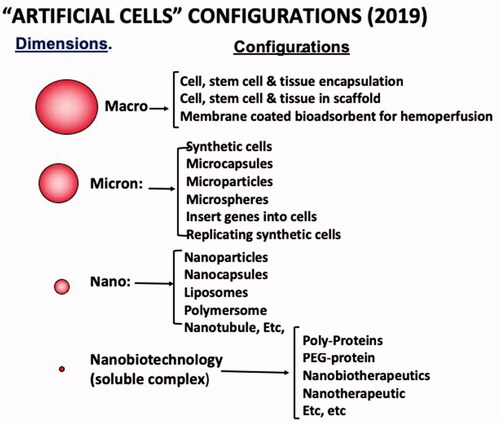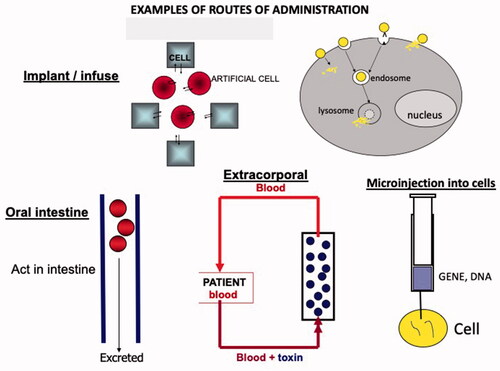Figures & data
Figure 1. Upper (from left to right): Basic idea of artificial cells that led to different types of early artificial cells. Lower: Present status of artificial cells with unlimited variations in contents, membrane material and dimensions. Updated from Chang [Citation9,Citation10] with copyright permission.
![Figure 1. Upper (from left to right): Basic idea of artificial cells that led to different types of early artificial cells. Lower: Present status of artificial cells with unlimited variations in contents, membrane material and dimensions. Updated from Chang [Citation9,Citation10] with copyright permission.](/cms/asset/384813f5-2124-4293-826f-68e0f2bfbc58/ianb_a_1577885_f0001_c.jpg)
Figure 2. Artificial Cell dimensions: macro, micro, nano and soluble nanobiotechnologic. Examples of variations in configurations with new terminologies for each extension.

Figure 3. Examples of potential uses of the idea of Artificial Cells based on the above variations in configuration. Updates from Chang [Citation9,Citation10] with copyright permission.
![Figure 3. Examples of potential uses of the idea of Artificial Cells based on the above variations in configuration. Updates from Chang [Citation9,Citation10] with copyright permission.](/cms/asset/89c110fd-1f89-4b89-ad7c-280b9a2b47de/ianb_a_1577885_f0003_b.jpg)
Figure 4. Upper left: Original (Chang 1957) emulsion method of preparing micro-dimension artificial cells. Since extended to physical or chemical methods for microscopic and nanodimension artificial cells. Lower left:. Original (Chang 1957) drop method for the preparation of large artificial cells. This has been now been extended and modified for cell/stem cell encapsulation. Upper right: Basic method (Chang 1964 Science) of bifunctional agents to assemble and crosslink hemoglobin (Hb) into PolyHb that has evolved into the preparation of soluble polyhemoglobin and other biotherapeutics. Lower right: Basic method of conjugating hemoglobin to polymer (Chang 1964 Science) that has evolved into the use of other polymers like the Pegylation (PEG-protein) Updated from Chang [Citation9,Citation10] with copyright permission.
![Figure 4. Upper left: Original (Chang 1957) emulsion method of preparing micro-dimension artificial cells. Since extended to physical or chemical methods for microscopic and nanodimension artificial cells. Lower left:. Original (Chang 1957) drop method for the preparation of large artificial cells. This has been now been extended and modified for cell/stem cell encapsulation. Upper right: Basic method (Chang 1964 Science) of bifunctional agents to assemble and crosslink hemoglobin (Hb) into PolyHb that has evolved into the preparation of soluble polyhemoglobin and other biotherapeutics. Lower right: Basic method of conjugating hemoglobin to polymer (Chang 1964 Science) that has evolved into the use of other polymers like the Pegylation (PEG-protein) Updated from Chang [Citation9,Citation10] with copyright permission.](/cms/asset/0ab8ed16-ebad-498e-bb86-86cd0195ee86/ianb_a_1577885_f0004_c.jpg)
Figure 5. Contains examples of possible routes of administration for the function of artificial cells in the body. Generally speaking, regulatory agencies are less worry about the use of artificial cells that are not implanted or injected into the body. We therefore started with artificial cells that are not implanted but act in a device for the extracorporeal route. This has resulted in the early approval of the use of artificial cells in patients way back in 1980. This is in the form of a hemoperfusion device.

Figure 6. Left: Theoretical mass transfer of 5ml 0.01 um membrane thickness artificial cells with different diameters. This is compared an artificial kidney machine with a mass transfer of 1. Upper middle: Thus, artificial cells containing bioactive material can become efficient micro/nano dialyser/bioreactor. Right: 70 grams 90 micron diameter adsorbent artificial cells retained inside a small container by screens at either end. Its small size is compared to an artificial kidney. Updated from Chang [Citation9,Citation10] with copyright permission.
![Figure 6. Left: Theoretical mass transfer of 5ml 0.01 um membrane thickness artificial cells with different diameters. This is compared an artificial kidney machine with a mass transfer of 1. Upper middle: Thus, artificial cells containing bioactive material can become efficient micro/nano dialyser/bioreactor. Right: 70 grams 90 micron diameter adsorbent artificial cells retained inside a small container by screens at either end. Its small size is compared to an artificial kidney. Updated from Chang [Citation9,Citation10] with copyright permission.](/cms/asset/5f3a59b2-8a7d-4914-8cd6-cf0867a80bc8/ianb_a_1577885_f0006_c.jpg)
Figure 7. Upper left Present status of clinical uses of Hemoperfusion (from Chang et al , 2017 Book on hemoperfusion). Upper right: Example of a sleeping pill overdose suicidal patient (Chang et al 1973). Standard dialysis (AK) is not effective but hemoperfusion (HP) quickly lowered the plasma level and rapid recovery. Lower: Variations in the surface properties of artificial cell membranes. Updated from Chang [Citation9,Citation10] with copyright permission.
![Figure 7. Upper left Present status of clinical uses of Hemoperfusion (from Chang et al , 2017 Book on hemoperfusion). Upper right: Example of a sleeping pill overdose suicidal patient (Chang et al 1973). Standard dialysis (AK) is not effective but hemoperfusion (HP) quickly lowered the plasma level and rapid recovery. Lower: Variations in the surface properties of artificial cell membranes. Updated from Chang [Citation9,Citation10] with copyright permission.](/cms/asset/81630650-e864-4b8e-aedf-c3aad013107c/ianb_a_1577885_f0007_c.jpg)
Figure 8. Upper: comparing red blood cell substitutes to red blood cells. Lower Left: Artificial red blood cells of microscopic dimensions that can reversibly “crenate” in hypertonic solution. Lower Middle: Nano Artificial cells red blood of 80 nanometer mean diameters with Polyethylene-polylactide membrane. Lower right: 4 types of soluble nanobiotherapeutic complexes. Updated from Chang [Citation9,Citation10] with copyright permission.
![Figure 8. Upper: comparing red blood cell substitutes to red blood cells. Lower Left: Artificial red blood cells of microscopic dimensions that can reversibly “crenate” in hypertonic solution. Lower Middle: Nano Artificial cells red blood of 80 nanometer mean diameters with Polyethylene-polylactide membrane. Lower right: 4 types of soluble nanobiotherapeutic complexes. Updated from Chang [Citation9,Citation10] with copyright permission.](/cms/asset/7fd1b5d0-7fd9-4042-8ab0-96e22017859a/ianb_a_1577885_f0008_c.jpg)
Figure 9. Upper right: Arterial obstruction can result in stroke and heart attack. Red blood cells cannot flow through. PolyHb, a solution, can perfuse through. (Upper left) PolyHb-SOD-CAT, a solution can perfuse through to supply oxygen and remove oxygen radicals Lower right: Unlike PolyHb, reinfusion of PolyHb- SOD-CAT does not cause brain edema in rat brain ischemia. Lower left: Unlike PolyHb, PolyHb-SOD-CAT reperfusion in ischemic small intestine does not releases damaging oxygen radicals. Updated from Chang [Citation9,Citation10] with copyright permission.
![Figure 9. Upper right: Arterial obstruction can result in stroke and heart attack. Red blood cells cannot flow through. PolyHb, a solution, can perfuse through. (Upper left) PolyHb-SOD-CAT, a solution can perfuse through to supply oxygen and remove oxygen radicals Lower right: Unlike PolyHb, reinfusion of PolyHb- SOD-CAT does not cause brain edema in rat brain ischemia. Lower left: Unlike PolyHb, PolyHb-SOD-CAT reperfusion in ischemic small intestine does not releases damaging oxygen radicals. Updated from Chang [Citation9,Citation10] with copyright permission.](/cms/asset/d8db5c5a-cd76-4694-8f29-2340a6e9bd47/ianb_a_1577885_f0009_c.jpg)
Figure 10. Upper left: Polyhemoglobin-catalase-superoxide dismutase-carbonic anhydrase can have up to 6 times red blood cell enzyme concentration. In a rat hemorrhagic shock model with 2/3 blood volume loss and 90 mins sustained shock the result is as follow: Upper right: significant faster lowering of the elevated tissue pCO2 and Lower Right: faster recovery of the ischemic heart Middle right: intestine having better histological finding. Lower left: Test for anaphylactic reaction: no significant increase in tryptase nor histamine. Above figures from Chang’s group [Citation29,Citation32,Citation36].
![Figure 10. Upper left: Polyhemoglobin-catalase-superoxide dismutase-carbonic anhydrase can have up to 6 times red blood cell enzyme concentration. In a rat hemorrhagic shock model with 2/3 blood volume loss and 90 mins sustained shock the result is as follow: Upper right: significant faster lowering of the elevated tissue pCO2 and Lower Right: faster recovery of the ischemic heart Middle right: intestine having better histological finding. Lower left: Test for anaphylactic reaction: no significant increase in tryptase nor histamine. Above figures from Chang’s group [Citation29,Citation32,Citation36].](/cms/asset/e223b771-23b8-4cf8-a50d-2718f0ad0848/ianb_a_1577885_f0010_c.jpg)
Figure 11. Upper left: Nano artificial red blood cell (rbc) with biodegradable polymeric membrane and red blood cell enzymes. Upper middle: EM of PEG-PLA membrane nano artificial rbc with a mean diameter of 80 nanometer. Lower left: Circulation time of PEG-PLA membrane rbc in rats is 2x longer than Polyhemoglobin. Right: nano rbc contains substantial amount of nonfunctional lipid or polymer membrane. Soluble Hb nanoencapsulated nano rbc has functional oxygen carrying hemoglobin membrane. Updated from Chang [Citation9,Citation10,Citation13] with copyright permission.
![Figure 11. Upper left: Nano artificial red blood cell (rbc) with biodegradable polymeric membrane and red blood cell enzymes. Upper middle: EM of PEG-PLA membrane nano artificial rbc with a mean diameter of 80 nanometer. Lower left: Circulation time of PEG-PLA membrane rbc in rats is 2x longer than Polyhemoglobin. Right: nano rbc contains substantial amount of nonfunctional lipid or polymer membrane. Soluble Hb nanoencapsulated nano rbc has functional oxygen carrying hemoglobin membrane. Updated from Chang [Citation9,Citation10,Citation13] with copyright permission.](/cms/asset/1f301276-ec42-4a50-b782-48922ce0f824/ianb_a_1577885_f0011_c.jpg)
Figure 12. Left: Biodegradable membrane artificial cells containing enzymes, hormones, vaccines and other biologicals (Chang, 1976). Variations result in the release of insulin at different rates. Extended now to many different configurations and dimensions. Right: Artificial cells containing magnetic material. Updated from Chang [Citation9,Citation10] with copyright permission.
![Figure 12. Left: Biodegradable membrane artificial cells containing enzymes, hormones, vaccines and other biologicals (Chang, 1976). Variations result in the release of insulin at different rates. Extended now to many different configurations and dimensions. Right: Artificial cells containing magnetic material. Updated from Chang [Citation9,Citation10] with copyright permission.](/cms/asset/d82f986b-7844-4200-bac6-72ddb02b98c0/ianb_a_1577885_f0012_c.jpg)
Figure 13. Left: Enzymes inside artificial cells, unlike those in free solution, do not have immunological problems. These can be in the form of membrane encapsulation, protein encapsulation or PEG covering of the enzyme molecule. Right: This approaching has been studied for a number of medical applications. Updated from Chang [Citation9,Citation10] with copyright permission.
![Figure 13. Left: Enzymes inside artificial cells, unlike those in free solution, do not have immunological problems. These can be in the form of membrane encapsulation, protein encapsulation or PEG covering of the enzyme molecule. Right: This approaching has been studied for a number of medical applications. Updated from Chang [Citation9,Citation10] with copyright permission.](/cms/asset/e34114fe-adcd-49f7-a779-974f4583e6b8/ianb_a_1577885_f0013_c.jpg)
Figure 14. Upper left: Cells inside artificial cells protected from outside. Lower: Cells can be bioencapsulated inside artificial cell or entrapped in scaffold of fibers or nanofibers Upper right: Bioencapsulation of islets, cells, genetically-engineered cells, microorganisms and stem cells. Updated from Chang [Citation9,Citation10] with copyright permission.
![Figure 14. Upper left: Cells inside artificial cells protected from outside. Lower: Cells can be bioencapsulated inside artificial cell or entrapped in scaffold of fibers or nanofibers Upper right: Bioencapsulation of islets, cells, genetically-engineered cells, microorganisms and stem cells. Updated from Chang [Citation9,Citation10] with copyright permission.](/cms/asset/12e7cac8-ea5d-4555-997a-ef31d8c0f6d4/ianb_a_1577885_f0014_c.jpg)
Figure 15. Artificial cells containing cells can only function for up to 1 year after implantation. This has been resolved by (1) biomaterial and method improvement (2) use in regenerative medicine that only need 3-4 months of function for example stem cells in liver regeneration. (3) Oral administration and (4) the use of biodegradable scaffold. Updated from Chang [Citation9,Citation10] with copyright permission.
![Figure 15. Artificial cells containing cells can only function for up to 1 year after implantation. This has been resolved by (1) biomaterial and method improvement (2) use in regenerative medicine that only need 3-4 months of function for example stem cells in liver regeneration. (3) Oral administration and (4) the use of biodegradable scaffold. Updated from Chang [Citation9,Citation10] with copyright permission.](/cms/asset/a57d38c3-6c74-4bd9-bda1-da00890ea7ac/ianb_a_1577885_f0015_c.jpg)
Figure 16. Upper: Artificial cells containing multienzyme systems with cofactor recycling can convert waste, urea and ammonia , into useful essential amino acids, Upper right: Artificial cells that contain liver cytosol and organelles like microsomes) Lower right: Reverse hemolysis to load red blood cells with drugs. Microinjection to introduce synthetic DNA into microbes. Updated from Chang [Citation9,Citation10] with copyright permission.
![Figure 16. Upper: Artificial cells containing multienzyme systems with cofactor recycling can convert waste, urea and ammonia , into useful essential amino acids, Upper right: Artificial cells that contain liver cytosol and organelles like microsomes) Lower right: Reverse hemolysis to load red blood cells with drugs. Microinjection to introduce synthetic DNA into microbes. Updated from Chang [Citation9,Citation10] with copyright permission.](/cms/asset/98a8ec57-6619-416d-92c5-029c55d53210/ianb_a_1577885_f0016_c.jpg)
